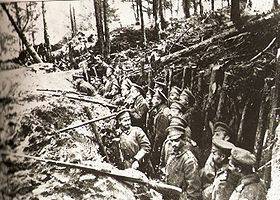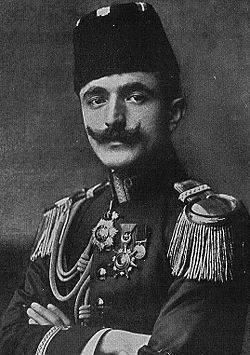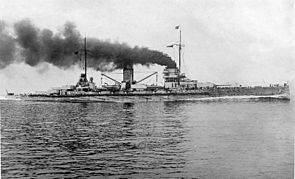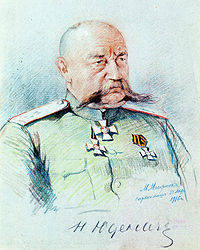Caucasian Front in the First World War. Part of 1.
 The fighting began in November 1914, after the Ottoman Empire attacked the Russian Empire and lasted until March 1918, when the Brest Peace Treaty was signed.
The fighting began in November 1914, after the Ottoman Empire attacked the Russian Empire and lasted until March 1918, when the Brest Peace Treaty was signed. It was the last major military conflict between Russia and Turkey. And it ended tragically for both empires (the Russian and the Ottoman), both powers could not bear the weight of the First World War and collapsed.
The war began with the fact that 29 and 30 in October 1914, the German-Turkish fleet under the command of German admiral Wilhelm Sushon fired at Sevastopol, Odessa, Feodosia and Novorossiysk (in Russia this event received the unofficial name "Sevastopol wake-up"). On October 30, Emperor Nicholas II ordered a diplomatic mission to be recalled from Istanbul, on November 2 of the year 1914, Russia declared war on Turkey. 5 and 6 November followed by England and France. Turkey’s entry into the war interrupted maritime communications between Russia and its allies through the Black and Mediterranean Seas. Thus, in Asia, the Caucasian Front arose between Russia and Turkey.
The reasons and prerequisites prompted the Ottoman Empire to enter the war
- The difficult social and economic situation of the empire, it was in a phase of decomposition, was in fact a semi-colony of great powers (Great Britain, France, Germany). Only desperate measures, such as a successful big war or large-scale reform, could temporarily stabilize the situation.
- Revanchism. Turkey at the beginning of the 20 century lost two wars: Tripolitan (Libyan) with Italy from 29 September 1911 of the year to 18 of October 1912 of the year, having lost Tripolitania and Cyrenaica, (modern Libya), as well as the island of Rhodes and the Greek speaking Dodecanese archipelago near Asia Minor. The First Balkan War from 25 September (8 October) [3] 1912 to 17 (30) in May 1913 against the Balkan Union (Bulgaria, Greece, Serbia, Montenegro), having lost almost all territories in Europe, except Istanbul and the district (were able to repel Adrianople-Edirne during the Second Balkan War - 29 June - 29 July 1913 year), the island of Crete.
- Union with the German Empire. Only the help of a great power could preserve the integrity of the Ottoman Empire and give it the opportunity to return part of the lost territories. But the Entente powers believed that the Turks were small, everything was predetermined for them. Germany, on the other hand, needed Turkey to use its million-strong army to draw off Russia's reserves and resources to the Caucasus, to create trouble for Britain in Sinai and Persia.
- In the field of ideology, the place of the Ottoman doctrine of the empire calling for unity and brotherhood of all peoples of the empire was gradually taken by extremely aggressive concepts of Pan-Turkism and Pan-Islamism. Pan-Turkism, as a doctrine of the so-called unity of all Turkic-speaking peoples under the supreme rule of the Ottoman Turks, was used by the Young Turks to implant nationalist feelings and sentiments among the Turks. The Pan-Islam doctrine, which called for the unification of all Muslims under the rule of the Turkish Sultan as caliph, was largely, like Pan-Turkism, directed against Russia, but was used by the Young Turks and in internal political affairs, in particular as ideological weapon in the fight against the Arab national liberation movement.
The outbreak of war
 Since the beginning of the war in Turkey, there was no agreement on the question of whether to enter the war and on which side? In the unofficial Young Turks triumvirate, War Minister Enver Pasha and Minister of the Interior Talaat Pasha were supporters of the Triple Alliance, but Jemal Pasha was a supporter of the Entente. Despite the open support of Germany, the Ottoman Empire formally maintained neutrality in the first 3 months of the war, hoping that the Entente countries were interested in the neutrality of sultan Turkey and they would be able to get significant concessions from them.
Since the beginning of the war in Turkey, there was no agreement on the question of whether to enter the war and on which side? In the unofficial Young Turks triumvirate, War Minister Enver Pasha and Minister of the Interior Talaat Pasha were supporters of the Triple Alliance, but Jemal Pasha was a supporter of the Entente. Despite the open support of Germany, the Ottoman Empire formally maintained neutrality in the first 3 months of the war, hoping that the Entente countries were interested in the neutrality of sultan Turkey and they would be able to get significant concessions from them.On August 2, 1914, a German-Turkish union treaty was signed, according to which the Turkish army was actually surrendered under the leadership of the German military mission, and mobilization was announced in the country. Hundreds of thousands of people were divorced from their usual work. Within 3 days, all men aged 20 to 45 years were required to appear at mobilization points. Over 1 million people have moved to their home posts. But at the same time, the Turkish government issued a declaration of neutrality. On August 10, German cruisers Goeben and Breslau entered the Dardanelles Strait, escaping the pursuit of the British fleet in the Mediterranean Sea. With the advent of these ships, not only the Turkish army, but also the fleet were under the command of the Germans. On September 9, the Turkish government announced to all powers that it had decided to abolish the surrender regime (special legal status of foreign citizens).
However, most members of the Turkish government, including the Grand Vizier, still opposed the war. Then the Minister of War Enver Pasha, along with the German command (Liman von Sanders), started the war without the consent of the rest of the government, putting the country before a fait accompli. 29 and 30 in October 1914, the German-Turkish fleet under the command of German admiral Wilhelm Sushona fired at Sevastopol, Odessa, Feodosia and Novorossiysk (in Russia this event received the unofficial name "Sevastopol wake-up"). On October 30, Emperor Nicholas II ordered a diplomatic mission to be recalled from Istanbul, on November 2 of the year 1914, Russia declared war on Turkey. 5 and 6 November followed by England and France. Turkey’s entry into the war interrupted maritime communications between Russia and its allies through the Black and Mediterranean Seas. Thus, in Asia, the Caucasian Front arose between Russia and Turkey.
 Russian Caucasian Army: composition, commanders, training
Russian Caucasian Army: composition, commanders, trainingIn 1914, the Caucasian Army consisted of: Field Administration (headquarters), Army subunits, 1-y Caucasian Army Corps (as part of 2-x infantry divisions, 2-x artillery brigades, 2-Kuban Plastun brigades, 1-o Caucasian Cossack Division), 2 th Turkestan Army Corps (as part of 2 rifle brigades, 2 rifle artillery battalion, 1 th Transcaspian Cossack brigade). Before the outbreak of hostilities, the Caucasian army was dispersed into two groups in accordance with two main operational areas:
Kara direction (Kars - Erzerum) - approx. 6 divisions in Olty - Sarıkamıs,
Erivan direction (Erivan - Alashkert) - approx. 2 divisions, reinforced by a significant number of cavalry, in the area Igdir.
The flanks were covered with small detachments formed from border guards, Cossacks and militia: the right flank - the direction along the Black Sea coast to Batumu, and the left - against the Kurdish regions, where with the announcement of mobilization the Turks began to form the Kurdish irregular cavalry, and Persian Azerbaijan. Total Caucasian army numbered approx. 153 battalions, 175 Cossack hundreds and 350 guns.
With the beginning of the First World War, the Armenian volunteer movement developed in Transcaucasia. Armenians pinned certain hopes on this war, counting on liberation of Western Armenia with the help of Russian weapons. Therefore, the Armenian socio-political forces and national parties declared this war just and declared unconditional support to the Entente. The leadership of Turkey, for its part, tried to attract Western Armenians to its side and invited them to create volunteer detachments as part of the Turkish army and persuade the Eastern Armenians to jointly oppose Russia. These plans, however, were not destined to be realized.
 The Armenian National Bureau in Tiflis was involved in the creation of Armenian squads (volunteer units). The total number of Armenian volunteers was up to 25 thousand people. The first four volunteer detachments joined the ranks of the army in various sectors of the Caucasian Front in November 1914. Armenian volunteers distinguished themselves in battles for Van, Dilman, Bitlis, Mush, Erzerum and other cities of Western Armenia. At the end of 1915 - the beginning of 1916. Armenian volunteer detachments were disbanded, and on their basis rifle battalions were created as part of the Russian units, which participated in hostilities until the end of the war.
The Armenian National Bureau in Tiflis was involved in the creation of Armenian squads (volunteer units). The total number of Armenian volunteers was up to 25 thousand people. The first four volunteer detachments joined the ranks of the army in various sectors of the Caucasian Front in November 1914. Armenian volunteers distinguished themselves in battles for Van, Dilman, Bitlis, Mush, Erzerum and other cities of Western Armenia. At the end of 1915 - the beginning of 1916. Armenian volunteer detachments were disbanded, and on their basis rifle battalions were created as part of the Russian units, which participated in hostilities until the end of the war.At the initial stage, the commander-in-chief of the Caucasian army was the Caucasian governor-general and the commander-in-chief of the troops of the Caucasian military district, Adjutant-General I. I. Vorontsov-Dashkov, his headquarters was in Tiflis. He, however, practically did not take part in the development of operations and command of the troops, transferring command of the army to his assistant, General A. Z. Myshlaevsky and Chief of Staff, General Yudenich. And after A. Z. Myshlaevsky was displaced in January 1915 - to General N. N. Yudenich, who commanded the army and after transforming it into the Caucasian front in April 1917. The direct command and control of the troops was in the hands of the commander of the 1 Caucasian Corps, General G. E. Berkhman, who was appointed head of the Sarykamysh detachment - this was the name of the Russian troops operating in the Erzurum direction.
In April 1917, the Caucasian Army was transformed into the Caucasian Front.
The Caucasian army did not have mountain equipment. Only mountain batteries were adapted for operations in mountain conditions.
Troops for action in the mountain theater were poorly trained; peacetime maneuvers were usually made in wide mountain valleys. When training the troops, the experience of the Russian-Japanese war was taken into account. However, the senior and especially the top commanders, as in the Turkish army, were poorly trained in driving large troop formations in independent columns in areas isolated by mountain relief. There were practically no modern means of communication (radio communication), no engineering was established (before the battle the troops practically did not dig in, but only indicated positions), there were no ski units, the troops were poorly controlled.
The disadvantages were compensated by the fact that the enemy suffered the same shortcomings, and the Russian soldier was superior in quality to the Turkish one. The Russians tolerated difficulties well, defended themselves stubbornly, were more savvy, were not afraid of direct combat, even with a superior opponent. And the younger, the average commanders as a whole knew their business.
Plans of the parties, the Turkish army
The main object of action on the part of the Russian army, besides the enemy’s manpower, was the Erzerum fortress, located 100 km from the Russian-Turkish border. Erzurum covered Anatolia from the land - this main territory of Turkey, where the main objects of the empire's economy were located and had a homogeneous population, most of which were Ottoman Turks. From Erzurum a direct path opened to Istanbul-Constantinople, which, together with the Bosphorus and Dardanelles, by the consent of the Entente allies, was to become part of the Russian Empire. Also in the empire were to enter the land historical Armenia, which were part of Turkey.
For the Turks, the main object of action after the defeat of the Caucasian army was the seizure of Tiflis - the political center of Transcaucasia and the knot of the main ways; Baku - industrial center (oil); Fortress Kars and Batum, which was the best port on the southern coast of the Black Sea. The Ottomans dreamed of seizing the whole of Transcaucasia, and in the future they planned to raise the Islamic ethnic groups of the North Caucasus against Russia, perhaps to raise a rebellion in Central Asia.
Two wars that were waged by Turkey - Tripolitan and Balkan - caused a great upset of the Turkish armed forces. The army for the new war was unprepared. After 1912, the crew experienced a purge, as a result of which a whole number of commanders were dismissed, and persons were nominated in their place at the discretion of the Minister of War Enver Pasha. The German mission, invited by the Turkish government in 1913, streamlined the matter somewhat. However, the weakest side of the Turkish army was its commanding staff. For example, the junior commanding staff was illiterate at 75%, the average at 40% consisted of non-commissioned non-commissioned officers, without special military education. The senior and top commanders, having a general military education, were very poorly prepared for driving troops in a modern war and, moreover, in the mountains.
The mobilization of the 3 of the Turkish army operating against the Caucasian army was carried out with great difficulty due to an acute shortage of artillery, food and fodder supplies. The 3-I Turkish army consisted of 9-th, 10-th, 11-th army corps, 2-th cavalry division, four and a half Kurdish equestrian divisions and two infantry divisions, arrived to strengthen this army from Mesopotamia, under the leadership of Gass Izzet Pasha, then War Minister Enver Pasha himself arrived. Total about 100 infantry battalions, 35 cavalry squadrons, 250 guns.
Kurdish formations in the military were completely unprepared and poorly disciplined. The artillery was armed with the guns of modern Schneider and Krupp systems. The infantry was armed with a Mauser rifle.
Due to the small number of trained personnel and the lack of telephone and telegraph equipment, communication was in most cases supported by equestrian messengers and delegates for communication.
According to the German officers, who had studied the Turkish army well, the Turks could attack, but were not capable of a quick, energetic onslaught. In the forced marches they were not trained, as a result of which there was a danger of decomposition of the troops. The army was poorly equipped and therefore could not spend in the open field on bivouacs for several nights in a row, especially in winter. The organization of the supply required a lot of time and slowed the pace of the offensive.
All these circumstances were taken into account by the Turkish command of the army with possible variants of operations, which were calculated not on deep advancement, but on an offensive with limited objectives from one line to another.
Information